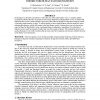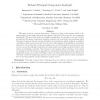413 search results - page 11 / 83 » Face recognition using mixtures of principal components |
CORR
2010
Springer
13 years 5 months ago
2010
Springer
In this paper we describe a procedure to reduce the size of the input feature vector. A complex pattern recognition problem like face recognition involves huge dimension of input ...
CVPR
1999
IEEE
14 years 9 months ago
1999
IEEE
We introduce in this paper a new face coding and recognition method which employs the Enhanced FLD (Fisher Linear Discrimimant) Model (EFM)on integrated shape (vector) and texture...
ICPR
2008
IEEE
14 years 2 months ago
2008
IEEE
This paper identifies a novel feature space to address the problem of human face recognition from still images. This is based on the PCA space of the features extracted by a new m...
JACM
2011
12 years 10 months ago
2011
This paper is about a curious phenomenon. Suppose we have a data matrix, which is the superposition of a low-rank component and a sparse component. Can we recover each component i...
ICIAR
2004
Springer
14 years 1 months ago
2004
Springer
Previous work has shown that principal component analysis (PCA) of three-dimensional face models can be used to perform recognition to a high degree of accuracy. However, experimen...


